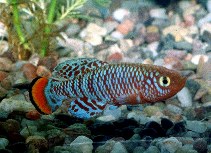| Diagnosis: |
Dorsal spines (total): 0-0; Dorsal soft rays (total): 15-17; Anal spines: 0-0; Anal soft rays: 15-18. Diagnosis: Nothobranchius rachovii is distinguished from other species of the genus by the following combination of characters: in males, a bright colouration consisting of alternating light blue and orange-red bars on the body and fins, orange-red head, and orange subterminal and black terminal bands in the caudal fin (Ref. 85866). It can be distinguished from the other species of the subgenus Nothobranchius as follows: from N. furzeri by male colouration, higher number of dorsal fin rays, 15-17 vs. 14-15, and a lower number of scales on the mid-longitudinal series, 26-28 vs. 28-30; from N. orthonotus by male colouration, lower number of scales on the mid-longitudinal series, 26-28 vs. 28-33, and shape of the dorsal profile, convex vs. flat; and from N. kadleci by male colouration and shape of the frontal region, higher number of dorsal and anal fin rays, 15-17 vs. 13-14 and 15-17 vs. 13-14 (Ref. 85866). Females can be distinguished by the presence of a reflective light blue spot on all scales of the flanks, vs. few, irregularly dispersed light blue-green spots in N. furzeri and N. kadleci or frequent presence of brown spots on body and fins in N. orthonotus (Ref. 85866). Nothobranchius rachovii can also be distinguished from all other species of the genus by its low number of diploid chromosomes, 2n=16 (Ref. 85866).
Description: A robust Nothobranchius species of medium size; snout pointed, mouth terminal, slightly directed upward; body laterally compressed and deep; dorsal profile slightly concave on head, convex from nape to end of dorsal fin; in older males more convex than in younger specimens; upper and lower profiles of caudal peduncle nearly straight (Ref. 85866). Supra-orbital squamation of G-type; frontal part of supraorbital squamation partly covered with epidermal tissue; frontal and central supraorbital neuromast systems, on top of the head, fused and forming two distinct shallow grooves; both lined with three shallow lobes at both sides of the groove; posterior cephalic neuromast systems in two curved pits (Ref. 85866). Dorsal fin rays 15-17, anal fin rays 15-18, relative position of base of first dorsal-fin ray over base of second or third anal-fin ray; pelvic fins short, not reaching origin of anal fin; pectoral fins reaching to origin of pelvic fins (Ref. 85866). Scales on the median longitudinal line 26-28 plus 2-3 on caudal fin base, most with a shallow pit in centre; transverse row of scales above pelvic fins 11-12, circumpeduncular scales 12-13 (Ref. 85866).
Colouration: Live male: general body colour iridescent light blue to pale blue-green or blue- grey, variable according to population; head and throat orange, grading across operculum into light blue of body; posterior margin of scales orange-red to brown-red, giving a strong reticulated appearance; locally, scale margins are wider and merge to form chevron-shaped cross-bars, apex rearward; dorsal and anal fins pale blue to light blue-grey, distally with orange-red to red-brown spots and stripes; dorsal fin with narrow blue-white margin; caudal fin pale blue to blue-grey with orange-red to red-brown spots and bars in the basal half, followed by a brown band grading into a wide orange subterminal band; caudal fin margin black; ventral fins light blue with some small red proximal spots; pectoral fins pale translucent orange with light blue margin; iris golden with dark vertical bar (Ref. 85866). Live female: body colour olive grey-brown, frontal scales on flanks with iridescent light blue to silvery centers; all fins colourless; iris bronze to golden with dark vertical bar (Ref. 85866). |
